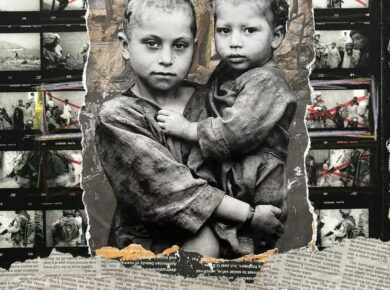Disclaimer: This article solely reflects the opinion of the authors and should not be taken to represent the general views of IPPR’s management/ editorial team or those of fellow authors
Human trafficking, sex trafficking, forced labor, forced prostitution, these terms often get muddled together without discrimination—most likely because they all belong in some dark moral area that none of us want to access. Nor contemplate.
Yet, these issues are distinct, for the most part, and clarifying these differences is the only way we can attempt to establish whether some of these factors lead to others and therefore how to stop them. I will draw some key conceptual distinctions before diving into the different elements of sex trafficking and how we might go about stopping it.
Human trafficking refers to the illegal trade of human beings, involving any form of recruiting, transporting and harboring victims through the use of coercion and force. Sex trafficking falls under the umbrella of human trafficking but refers exclusively to the trafficking relating to the sex industry. This can be in the form of forced prostitution, recruitment for pimps, pornography, stripping, waitressing, or other forms of adult entertainment or commercial sex acts.
Prostitution, on the other hand, can sometimes fall under the umbrella of sex trafficking but can also refer to independent action, and that is the act of selling sexual services. This can be forced, or not. We typically understand forced prostitution as being a by-product of the sex trafficking industry. This is also distinct from forced labor, though this can include forced prostitution. Forced labor refers to work that is typically unpaid or whose profits are generally sequestered away from the victim which occurs through coercion or threat to the victims.
While distinct, it is easy to see how these might become intertwined in many instances, blurring lines in what is already a murky moral and legal area. While some countries may legalize prostitution and condemn trafficking, others might criminalize both but turn a blind eye or lack enforcement capabilities to stop it. This is what makes sex trafficking so susceptible to the high levels of organization that we witness in other criminal areas such as the narcotics scene.
Who are the victims?
Victims of sex trafficking are 80% female and 50% minor, often from economically or socially vulnerable groups. Young girls in rural areas where poverty is common, education prospects are inexistent and gender relations are determined by male dominance are common victims. This allows traffickers to lure them in with promises, and their vulnerability and lack of viable alternatives result in their being trafficked.
Another common set of victims, exemplified by the case of China, are women whose families do not want them. Particularly in the aftermath and context of the One-Child Policy, in which female offspring were undesirable. Families, then desperate for baby boys sold their female offspring to traffickers. Women remained the main target of this trafficking due to the ease to obtain new recruits, with an estimated 50 to 100 million missing women across the country.
Similarly, Nepalese girls are also easy targets for traffickers, for the consensual ideologies surrounding gender roles in the country mean that women are entirely at the mercy of their male counterparts. The vast network of black-market work for women in the country makes it that much easier for traffickers to access a pool of potential victims. Eager to get away under the promise of a better, paid job and life in another country, women from remote villages whose fathers are ready to give them away to another are also common targets in Nepal.
How do they recruit?
When it comes to recruitment, traffickers employ a wide array of strategies. From debt bondage to traumatic bonding, finesse, and guerilla pimping, tactics are varied and depend vastly on the type of target.
Debt bondage usually occurs with the promise of cash, used to lure in victims who end up accepting gifts from the trafficker, and are then trapped into pledging personal services to repay the debt from such gifts. This puts the victim in perpetual repayment for the initial gift, with no way out.
Traumatic bonding is not so psychologically subtle. Victims are raped, beaten, drugged, and locked in closets in order to generate fear so profound that they become grateful for being left alive by their captors, and then engage in illicit activities in order to demonstrate this gratitude and in fear of further punishment. This tactic is incredibly coercive and somewhat rarer—victims from economically distressed backgrounds are lured in easily with promises of money or employment.
With regards to pimping, guerilla pimping uses traumatic bonding, while finesse pimping involves psychological games of kindness and debt-creation.
What all of these techniques have in common is that they result in the capture of a victim, who may only realize she is entrapped once transported to another country, where passports, permits, or other identification are withheld or destroyed by the captor. This renders it virtually impossible to escape and can lead to legacy prostitution, where a child is born into the trafficking system without an identity in the formal sense.
What of their organization?
Sex trafficking, particularly internationally, has many of the characteristics of other forms of organized crime, with clear hierarchies, routes, and reward systems. In fact, many hubs—or centers for trading sexually trafficked victims—are controlled by high-profile crime syndicates which also exert influence in the drug, arms, or organ industry.
Pimps, once well established, usually delegate to a “bottom”—a person previously trafficked who has worked sufficiently long for the pimp as to have earned trust—all daily tasks such as coordinating trafficked prostitutes and ensuring that profits are brought back to the pimp. This delegation system enables the industry to grow internationally in the same way other illicit activities do.
From where to where?
Trafficking does not occur in a single location, it starts, spreads, and ends all across the globe, with networks stretching across borders. Source countries are typically less economically developed, which is why recruitment can occur in the way it does. Recently, these have also been industrialized countries such as states from the ex-Soviet bloc, where unemployment is high (this is well illustrated by the transit of Ukrainian women to Israel, for instance).
Transit countries are typically those in which there is high political instability and slow bureaucracy, where forging documents, bribing officials, and getting across borders is simple.
Destination counties are generally more affluent, and cover for the activity is generally provided by large cities where other criminal activities take place and a structure for underground work is already well established.
How might we stop it?
I alluded to the numerous causes of trafficking, particularly ease of recruitment, such as poverty, low economic opportunities, and high gender inequality. Tackling these issues is therefore the best place to start when it comes to combatting trafficking. While attempting to reduce demand by dismantling some branches of networks, the sex trafficking industry is so fast-growing and so deep underground that its very magnitude is unknown. It is like a tri-headed dog; cutting one of its heads off will not kill the beast.
I propose that more research be done on the specific facilitators of recruitment, so that we may strive to eliminate those in order to reduce the supply of victims, as opposed to that of criminals.
Sex trafficking is difficult to address also in part because it is morally upsetting in ways that go beyond the condemning of criminal activities, there is something specific about the injustice, abuse, and pain that victims go through which seems to sit particularly wrongly in our stomachs. This should be reason enough for us to address it more thoroughly than we currently are, as opposed to hiding behind ignorance because we refuse to stomach the horrors others are going through.
By Valentina Laugeri,
My name is Valentina, and I am in the second year of my Bachelor’s degree in Politics and International relations. This exciting journey is for me a way to link my passion and my studies and discover new topics and perspectives. I am excited to share my articles and ideas!







